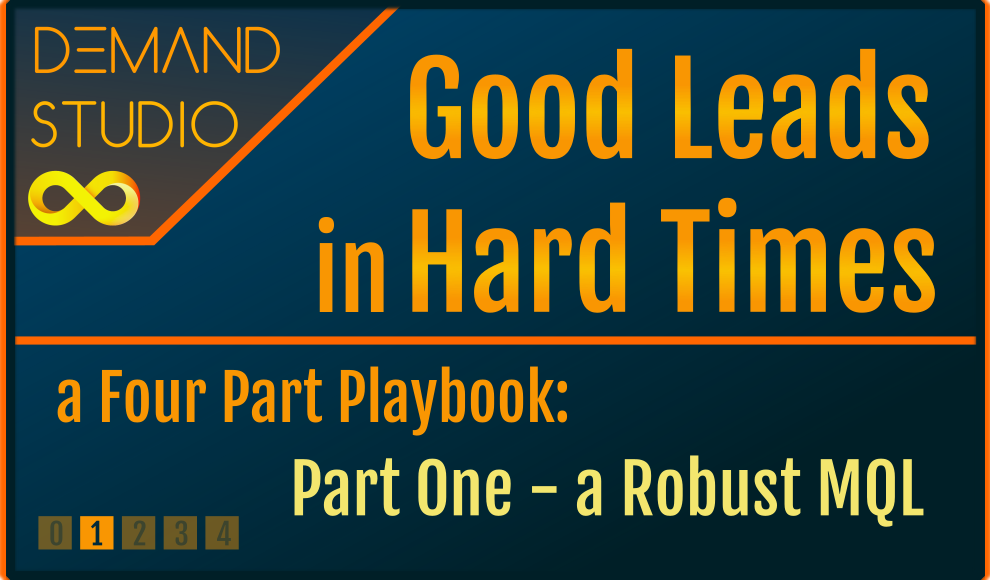Miniseries│Good Leads in Hard Times │ Part 1: What Makes a Robust MQL? – 5 steps to Optimizing Top of the Funnel Leads
A brief online engagement, or opt-in agreement, is of course helpful. A good sign. But it is not necessarily indicative of a future purchase. All too often marketers drive for top of the funnel leads and hope that, by the law of averages, or really just hope, some will filter down to more meaningful interaction.
The mantra of quantity over quality means that too little attention is paid to leads that should be prioritized – time and cost pressures quickly convert into a “one size fits all” syndrome. Standard content, standard process, marketing by rote.
Improving the bottom of the funnel begins with starting demand generation the right way. Demand Studio has identified five steps to ensure this happens.
Step One – data strategy for outbound digital campaigns
Everyone knows the importance of data, but many still fail at the strategy stage. What data do you really need? Here are some of the questions you should ask:
- Do you know what your Total Addressable Market (TAM) is? And, if so, how narrowly did you define it?
- Are campaigns going to be structured around the whole TAM – or is further segmentation needed?
- Do you have an Ideal Customer Profile?
- Are you going to require third party data (for acquisition) or existing customer data and prospect lists?
- Are you planning to develop an ABM program (and depending on the answers to these questions you may not be ready for this yet).
Step Two – data execution
Now you have a strategy in place make sure that the data is fit for purpose.
- Are you able to integrate all available data sources? This goes beyond simply matching internal and third-party data to avoid duplication. Make sure that all the sources and their data fields are identified and used in segmentation. This will include current digital or even sales engagement.
- How much of the data fits the Ideal Customer Profile? There may be good reasons why it doesn’t – a new product launch for example – but otherwise outliers should probably be excluded. For more on the Ideal Customer Profile, go here.
- Are there gaps in account data “promotability”? Do you have the right contacts with opted-in emails at all the necessary accounts? If not, then either make sure you have integrated all data sources, or look for new ones.
Step Three – buyer’s journey and content alignment
How do you want to qualify responses and what journey do you want to take them on? Think this right the way through from the initial contact right through to the sale. This is often expressed in terms of awareness, engagement, consideration, evaluation, and sale. But get as granular as you can. Remember all the firmographic and cultural characteristics of your target. If you are marketing to small businesses in Mexico or Italy then your content will need to be in Spanish or Italian, and relevant to the local market.
Step Four – landing pages, offers, and web page identification
What exactly do you want the prospect to do? At this stage you are probably going to drive them to a landing page – either on your existing web site or a new microsite. Here are the points to remember:
- Will you be able to identify who is visiting the page, how they got there, and what they are looking at?
- Maximize personalization to visitors based on account and contact segmentation
- What do you want them to do? Opt-in, register to access gated content (and if you are gating content, why?)
- How does this accelerate the prospect’s progress along the journey?
- How “frictionless” is the experience? Too many obstacles to a quick review and understanding of what you are promoting?
- What do you want them to do next?
Step Five – results, reporting, what’s working and what is not, and next steps – which leads make the cut?
As we have noted above, quantity often trumps quality in early stages of the funnel, and so it is important to have robust metrics and concrete next steps.
- Go beyond opens, clicks and impressions
- Focus on content choices, time spent on pages, and repeat visits
- Test, test, test!
- Use won/loss analysis from past campaigns (i.e. what level of initial engagement converted to real sales? Use that insight to inform ongoing segmentation)
- Overlay intent data so that contact engagement can be seen in the context of overall account status
About Demand Studio
Demand Studio deploys best of breed solutions to support every stage of your interactions across the buyer’s journey. From top of funnel leads through to highly focused ABM tactics our data, engagement, content and calling services will optimize and accelerate revenue opportunities



